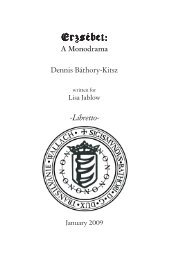Bolder Sounds 20 years of creative sample libraries - Báthory Erzsébet
Bolder Sounds 20 years of creative sample libraries - Báthory Erzsébet
Bolder Sounds 20 years of creative sample libraries - Báthory Erzsébet
Create successful ePaper yourself
Turn your PDF publications into a flip-book with our unique Google optimized e-Paper software.
The personal scenes in this opera have been fictionalized, but all the characters<br />
were real people <strong>of</strong> Renaissance Hungary.<br />
COUNTESS ERZSÉBET BÁTHORY (1564-1614), cousin to István <strong>Báthory</strong>, King<br />
<strong>of</strong> Poland and Prince <strong>of</strong> Transylvania, was said to have been a serial killer,<br />
indeed, the worst in history. In all, 612 women died—and in her diary, it<br />
was said, she documented their deaths. Though the diary itself has proven<br />
illusory, she nevertheless became known as “Hungary’s national monster,”<br />
and was (along with Vlad Dracul) the supposed model for Bram Stoker’s<br />
Dracula—a claim that is itself <strong>of</strong>ten disputed.<br />
<strong>Erzsébet</strong> was married to the warrior<br />
Count Ferenc Nádasdy, and she is said<br />
to have taken Anna Darvulia—a<br />
mysterious woman—as a lover<br />
during his frequent absences. The<br />
Countess had at least four children:<br />
Anna, Ursula, Katarina and Paul. In<br />
the course <strong>of</strong> her life, servants<br />
Dorattya Szentes, Ilona Joo and<br />
Katalin Beneczky reportedly became<br />
procurers <strong>of</strong> hundreds <strong>of</strong> servants<br />
girls who were tortured and died by<br />
<strong>Erzsébet</strong>’s hand. Defending her<br />
throughout was deformed servant<br />
Janos Ujvary.<br />
The death <strong>of</strong> Viennese singer Ilona Harczy led to her downfall. For<br />
dramatic purposes, the character <strong>of</strong> Harczy has been relocated from<br />
Augustinianstraße in Vienna, where <strong>Erzsébet</strong> heard her sing and later<br />
murdered her, to Cséjthe Castle (in present-day Cachtice, Slovakia), where<br />
most <strong>of</strong> her evil work was done over her 40 adult <strong>years</strong>. <strong>Erzsébet</strong> also<br />
maintained castles in Ecsed, Sárvár, Bicse (Bytca), Kéresztur, and Leka<br />
(Lockenhaus) during the turbulent political times that pitted the<br />
Habsburgs against the Ottomans. The line from Budapest to Pozsony (also<br />
known as Bratislava or Pressburg) to near Vienna was a constantly shifting<br />
battleground for more than a century.<br />
Countess. The crew was young and had done almost no research; they<br />
couldn’t pronounce the names, and had little idea what they were filming.<br />
It promised to be a disaster—though the trip back to Cachtice was an<br />
encouragement to revive the opera’s development. The program eventually<br />
ran as “World’s Bloodiest Dungeons” on the Travel Channel.<br />
Uden Television—now gone—interviewed the composer in <strong>20</strong>02, but the<br />
show was too controversial to be aired. About the same time, artist Bob<br />
Hobbs was in touch about creating a ‘virtual opera’—and Raymond<br />
McNally died. The change <strong>of</strong> millennium was an operatic nexus.<br />
A new chapter opened as the Discovery<br />
Channel sent an Australian team to<br />
Vermont in <strong>20</strong>04 to record interviews<br />
and an opera scene written for them. It<br />
was the first part <strong>of</strong> the opera written<br />
for voice, sung by Lisa Jablow and with<br />
a small ensemble <strong>of</strong> the composer’s<br />
musician friends. Discovery also<br />
produced a pair <strong>of</strong> tickets to Germany, where Dennis and Stevie met them<br />
for another trek to Slovakia and Cséjthe Castle, this time in a newly vibrant<br />
Slovakia restoring itself with European Union funds. The well-briefed crew<br />
set up interviews with townspeople, and two new opera team members<br />
signed up—European producer Martin Cikánek (first met with Pavel<br />
Kraus) and marketing coordinator Vit Sirek. The Discovery production<br />
aired for the next seven <strong>years</strong> as “Deadly Women.”<br />
With the bathory.org website buzzing, media requests continued to flood<br />
in: Weekly World News, the Globe, Requiem, Bloodcult, Horror Punks, SME<br />
television ... even though at this point there was actually no opera—just one<br />
prototype scene and one piano dance<br />
existed, along with numerous outlines. By<br />
<strong>20</strong>06, the composer had formalized the<br />
complete project and it became his PhD<br />
dissertation. The next year Cradle <strong>of</strong> Filth<br />
were in touch about a joint project, and<br />
Czech director Juraj Jakubisko released his



